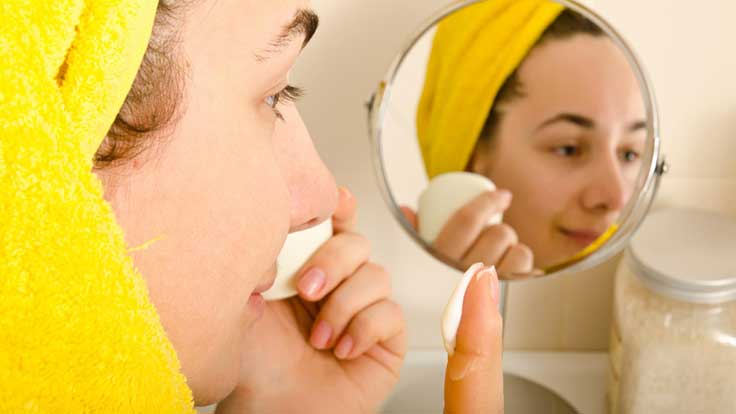When referring to a skin condition where there’s inflammation, redness, and ‘bumps’ on the face, people typically use the term ‘breaking out.’ This is to imply that their skin has received a stimulus that causes irregularities.
Acne vulgaris (or commonly referred to as just acne) is a skin condition wherein the hair follicles or pores are clogged with excess oil (sebum) production, dead skin cells, bacteria, and dirt.
Reports suggest that acne is the most common skin malady that affects people all across the globe. In the United States, over 40 to 50 million people suffer from acne. Around 54% of all women, and 40% of all men over the age of 25 have one form or another of acne.
Identifying Acne
Acne is a skin condition characterized by the development of any one (or all three) of the following:
- Whiteheads
- Blackheads, or
- Pimples
The skin appears inflamed, red, and is often textured. However, the manifestations of acne vary from one person to the next. There are several factors that contribute to the development of acne; some are based on diet, some on pollution, and some are just genetic.
One thing’s for sure, though - the implications of having a skin condition, especially one as unpredictable as acne, are often psychological as well as physiological. Acne typically appears around pubescence because of alternating hormone levels (male and female sex hormones).
The most common anatomical sites for developing skin lesions characteristic to acne are the face, neck, and the back. However, acne can virtually exist on any surface of the body where there’s a hair follicle.
Differentiating Between Manifestations of Acne
1. Whiteheads:
A whitehead (also known as a comedone) is an occluded pore. They’re similar to blackheads in the sense that the pore has been clogged with excess oil, bacteria, or dead skin cells.
However, whiteheads are covered by a layer of skin. This layer keeps them from being exposed to dirt and pollutants in the external environment and therefore they appear lighter.
2. Blackheads:
A blackhead (also known as a comedone) is an occluded pore that has contact with the external environment. The pore is clogged with excess oil, bacteria, or dead skin cells.
However, unlike a whitehead, there is communication with pollutants and dirt. Therefore, a blackhead will appear darker than a whitehead.
3. Pimples:
A pimple or a pustule is often seen as the most severe manifestation of acne (although cysts are more aggressive in character). Pimples are a direct result of inflammation in the skin.
If the hair follicle enlarges and eventually ruptures, the inflammatory products within the clogged follicle gain entry into deeper layers of the skin causing inflammation. This results in the formation of a pustule commonly referred to as a pimple.
4. Cysts:
Cystic formation is rare, but it is the most severe manifestation of acne. The inflammation has spread to deeper layers of the skin and caused a cavitation in the skin layers. The cavitation is filled with pus, blood, or anything of that sort.
Different Types of Acne
Acne is a multifactorial disease - there isn’t one sole incriminating factor that causes acne formation. Some people have genetic acne, some have hormonal acne, and some might develop the skin condition because of pollutants in the external environment.
The skin condition is therefore best described in terms of severity:
- Mild acne - Whiteheads outnumber both blackheads and pimple formation. There are no pimple marks left behind after acne subsides.
- Moderate acne - An almost equal amount of whiteheads, blackheads, and pimples. The chances of pimple marks being left behind are existent, but not to a worrying extent.
- Severe acne - Pimple formation is predominant and some cystic lesions might also develop. There will be pimple marks left behind after acne subsides.
Difference Between Acne and Pimples
It is important to understand that most people use the term ‘breaking out’ to refer to acne. Why? Because, as the term implies, your skin breaks out into pustules routinely.
It is also important to understand that acne is a multifactorial skin condition. Which means someone with hormonal acne in their teens has the capacity to develop stress acne when they’re older.
While the skin condition has a number of manifestations, most people think pimple or pustule formation is the most worrisome. While this might be true in part, pustule formation is often seen as the sole characteristic of acne.
Acne refers to a condition in which the hair follicles in the skin become enlarged and filled with excess sebum production (oil production). The initial manifestation of which would therefore be a whitehead and not a pustule (unless the sebum production is in deeper layers of the skin).
You need to be particularly vary about the differences between the skin condition and manifestation because pustules result in scar marks. To save yourself the trouble of rubbing one thing or another on your skin, identify and curb acne while it’s in its initial stages.
Why do we get Scar Marks?
A pustule is a cavitation in the skin. Basically, the hair follicle has enlarged and therefore made a ‘hole’ in the skin. This hole is filled with sebum, bacteria, and dirt.
If you pick at your pimple, it won’t heal naturally and the cavitation will therefore heal with excess melanin and soft tissue formation. As a result, the area appears textured compared to the rest of the skin and is often hyper-pigmented.
What Causes Acne and Pimples?
- Hormonal changes (at puberty, during menopause, and pregnancy)
- Stress related factors
- Diet (high carbohydrate diets, milk, and chocolate)
- Sleep irregularities
- Medications
- Pollutants, dirt, and excessive sweating
- Harsh exfoliation and aggressive skin care products
- Smoking and alcohol intake
- Low water intake
- Genetics
- Dandruff and oily hair resulting in acne on the forehead
How to Prevent Acne and Pimples?
It’s difficult to incriminate any one factor in causing acne. Someone who has acne in their teens could have dietary or stress-related acne instead of genetic or hormonal acne. With that being said, there are a few ways to curb or subdue acne irrespective of the causative type:
Medications:
Medications can cause and curb acne - steroids are incriminated most often in causing the skin condition. Benzoyl Peroxide, Retinoids, and some oral contraceptive pills are often advised in treating acne.
While acne is not a bacterial disease as perse, P.acne has been identified in several pustules. Dermatologists therefore also advise the use of erythromycin and clindamycin in treating acne.
Healthy Lifestyle:
A healthy lifestyle has been advocated for in every condition. Your acne might be related to inadequate water intake and improper sleep schedule causing your skin to breakout.
Skincare:
Harsh products and excessive exfoliation might exasperate acne formation. However, mild cleansers and oil-free products help in clearing your skin of acne. They do not have a therapeutic effect as per se.
However, skincare cleans your pores and prevents the formation of acne. Albeit they have little to no role in actually curbing or subduing acne once it forms.
Acne and Pimple Treatment:
Proper treatment for the skin condition can best be advised by a dermatologist. They’ll be able to identify the causative agent for your acne and what has been exasperating it.
Your doctor might advise skin culture tests and certain patch tests before prescribing medications and chalking up a treatment plan. All in all, acne is the most common skin condition in the world and therefore requires proper and timely treatment.












